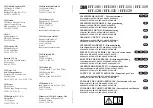
9.3.2.1
Inspecting the wiring
GUID-665B75A6-A074-4A03-ADF1-3D0FAD198E61 v8
The physical inspection of wiring connections often reveals the wrong connection for phase
currents or voltages. However, even though the phase current or voltage connections to IED
terminals might be correct, wrong polarity of one or more measurement transformers can
cause problems.
•
Check the current or voltage measurements and their phase information from Main
menu/Measurements/Analog primary values or Analog secondary values.
•
Check that the phase information and phase shift between phases is correct.
•
Correct the wiring if needed.
•
Change the parameter
Negation in Configuration/Analog modules/3 phase analog
group/SMAIn:1 (n= the number of the SMAI used).
Changing the
Negation parameter is not recommended without
special skills.
•
Change the parameter in PCM600, see PCM600 documentation.
•
Check the actual state of the connected binary inputs.
•
In LHMI, select Main menu/Test/Binary input values. Then navigate to the board
with the actual binary input to be checked.
•
Check the actual state of the connected binary inputs through PCM600, see PCM600
documentation.
•
Measure output contacts using the voltage drop method of applying at least the minimum
contact load given for the output relays in the technical data, for example 100 mA at 24 V
AC/DC.
Output relays, especially power output relays, are designed for breaking
high currents. Due to this, layers of high resistance may appear on the
surface of the contacts. Do not determine proper functionality of
connectivity or contact resistance by measuring with a regular hand-held
ohm meter.
1MRK 500 127-UEN D
Section 9
Troubleshooting
670 series
83
Operation manual






































